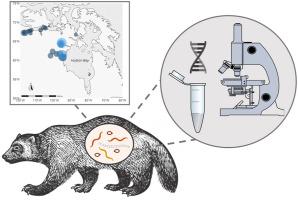International Journal for Parasitology: Parasites and Wildlife ( IF 2.0 ) Pub Date : 2020-10-16 , DOI: 10.1016/j.ijppaw.2020.10.004 Sophie E. Watson , Frank Hailer , Nicolas Lecomte , Pratap Kafle , Rajnish Sharma , Emily J. Jenkins , Malik Awan , Vincent L’Hérault , Sarah E. Perkins

|
Parasites are fundamental components within all ecosystems, shaping interaction webs, host population dynamics and behaviour. Despite this, baseline data is lacking to understand the parasite ecology of many Arctic species, including the wolverine (Gulo gulo), a top Arctic predator and scavenger. Here, we combined traditional count methods (i.e. adult helminth recovery, where taxonomy was confirmed by molecular identification) with 18S rRNA high-throughput sequencing to document the wolverine parasite community. Further, we investigated whether the abundance of parasites detected using traditional methods were associated with host metadata, latitude, and longitude (ranging from the northern limit of the boreal forest to the low Arctic and Arctic tundra in Nunavut, Canada). Adult parasites in intestinal contents were identified as Baylisascaris devosi in 72% (n = 39) of wolverines and Taenia spp. in 22% (n = 12), of which specimens from 2 wolverines were identified as T. twitchelli based on COX1 sequence. 18S rRNA high-throughput sequencing on DNA extracted from faeces detected additional parasites, including a pseudophyllid cestode (Diplogonoporus spp. or Diphyllobothrium spp.), two metastrongyloid lungworms (Angiostrongylus spp. or Aelurostrongylus spp., and Crenosoma spp.), an ascarid nematode (Ascaris spp. or Toxocara spp.), a Trichinella spp. nematode, and the protozoan Sarcocystis spp., though each at a prevalence less than 13% (n = 7). The abundance of B. devosi significantly decreased with latitude (slope = -0.68; R2 = 0.17; P = 0.004), suggesting a northerly limit in distribution. We describe B. devosi and T. twitchelli in Canadian wolverines for the first time since 1978, and extend the recorded geographic distribution of these parasites ca 2000 km to the East and into the tundra ecosystem. Our findings illustrate the value of molecular methods in support of traditional methods, encouraging additional work to improve the advancement of molecular screening for parasites.
中文翻译:

北极清道夫的寄生虫;金刚 狼(Gulo gulo)
寄生虫是所有生态系统中的基本组成部分,可塑造相互作用网,宿主种群动态和行为。尽管如此,仍缺乏基准数据来了解许多北极物种(包括金刚 狼(Gulo gulo)的寄生虫生态),这是北极的顶级掠食者和清道夫。在这里,我们将传统的计数方法(即成年蠕虫恢复,其中通过分子鉴定确认了分类学)与18S rRNA高通量测序相结合,以记录金刚狼寄生虫群落。此外,我们调查了使用传统方法检测到的大量寄生虫是否与寄主元数据,纬度和经度相关(从北方森林的北部边界到加拿大努纳武特的北极和北极苔原低地)。在肠内容物成虫寄生被鉴定为Baylisascaris devosi在72%(N = 39)和狼獾的带绦虫属。在22%(n = 12)中,其中来自2个金刚狼的标本被鉴定为T. twitchelli基于COX1序列。18S rRNA基因的高通量对DNA测序从粪便中提取检测的附加寄生虫,包括pseudophyllid绦虫(Diplogonoporus属或裂头属),两个metastrongyloid肺蠕虫(管圆线虫属或Aelurostrongylus属,和Crenosoma属物种),一个蛔虫线虫(A虫属或Toxocara属),旋毛虫属。线虫和原生动物的Sarcocystis spp。,尽管它们的患病率均低于13%(n = 7)。B. devosi的丰度随纬度显着降低(坡度= -0.68; R 2 = 0.17; P = 0.004),表明分配范围是北偏。自1978年以来,我们首次在加拿大金刚狼中描述了B. devosi和T. twitchelli,并将这些寄生虫的记录地理分布向东延伸了2000公里,并进入了苔原生态系统。我们的发现说明了分子方法在支持传统方法方面的价值,鼓励开展其他工作以改善对寄生虫的分子筛查的进展。











































 京公网安备 11010802027423号
京公网安备 11010802027423号